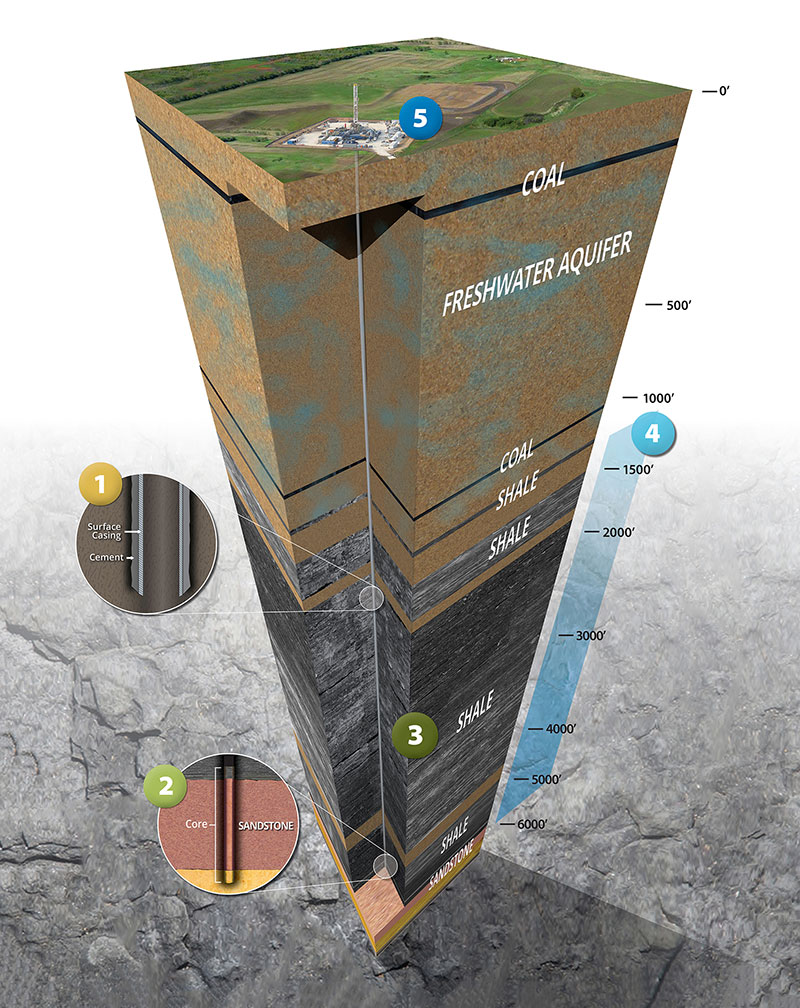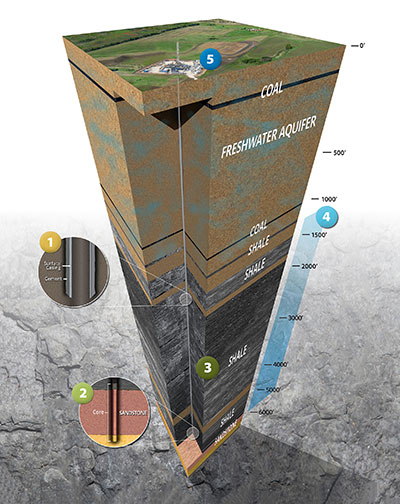- Products
- About
- Responsibility
- Environment
- News
- Contact us
- Careers
-
Environmental protection has always been a core value of Basin Electric. The cooperative advocated for responsible reclamation long before it was required by law, built and operates the largest wind project in the nation owned solely by a cooperative, and met 80% of its its nearly 50% load growth with wind, natural gas, and market purchases.
In addition to these and many other environmental efforts, Basin Electric is embarking on an innovative project that will benefit the environment by sequestering and permanently storing carbon dioxide (CO2) from its subsidiary Dakota Gasification Company’s Great Plains Synfuels Plant. The Great Plains CO2 Sequestration Project is a step toward North Dakota’s goal of being carbon neutral by 2030. It would also provide a path to receive the Internal Revenue Service’s 45Q tax credit for carbon sequestration projects.
The Synfuels Plant, located near Beulah, North Dakota, currently captures approximately 2 million metric tons of the plant’s CO2 emissions, which are piped to Saskatchewan for use in enhanced oil recovery. The proposed project would enable the facility to capture an additional 1.5 million metric tons of CO2 per year and would serve as part of the largest coal-based carbon capture projects utilizing geologic storage, while also being the first project in the nation to use both enhanced oil recovery and geologic storage.
“Dakota Gasification Company was already an early leader in CCUS (carbon capture, utilization, and sequestration), and this proposed expansion is another milestone in our state’s efforts to crack the code on this critical energy technology – the largest coal-based carbon capture project to use geologic storage,” U.S. Sen. John Hoeven (R-North Dakota) said during a press conference announcing the Great Plains CO2 Sequestration Project.
In September, Dakota Gas directors authorized a project to build the Dakota Carbon Pipeline, a 6.8-mile pipeline that will carry captured CO2 from the Great Plains Synfuels Plant to a permanent geologic storage reservoir near the plant.
The pipeline will cross reclaimed mine land and other utility development that is owned by Basin Electric and The Coteau Properties Company, which operates the Freedom Mine. Construction of the pipeline began in fall 2021 and is scheduled to be completed in summer 2022.
The Dakota Carbon Pipeline will carry the captured CO2 from the Synfuels Plant to injection wells located approximately three-and-a-half miles north of the plant. The injection wells will also be located on reclaimed land owned by The Coteau Properties Company, but will inject CO2 more than a mile below the surface in the Broom Creek (sandstone) formation (see graphic at bottom of page).
A test well was drilled in June 2021. Information gleaned from the test well will be used in a CO2 storage facility permit application to be sent to the North Dakota Industrial Commission, the agency that regulates the underground storage of CO2 in the state.
Seismic testing is currently being conducted at the project site as part of the ongoing baseline monitoring operations. Seismic surveys are a tool geologists and geophysicists use to understand subsurface geology by looking at rock layers miles under the ground. The data from the testing will give a baseline reading of the geology and formations of the area where the CO2 will be injected.
One of the most commonly asked questions about carbon sequestration is whether it is safe to inject CO2 underground.
The Industrial Commission’s CO2 storage facility permit application is hundreds of pages long and deals with all aspects of safety and environmental protection. A test well and seismic survey are just two of the tests required in the application, and no CO2 can be injected until the Industrial Commission approves the application, which is expected to happen the second half of this year. If the Commission approves the application, upcoming seismic surveys will track the movement of the CO2 after it is injected to ensure it stays within the Broom Creek Formation, which evidence shows it will.
“The geology in western North Dakota is really well suited for the underground storage of CO2,” says Kevin Solie, Basin Electric senior environmental compliance administrator. “Directly above and below the proposed injection site are nearly impervious 130-foot-thick rock formations that create tight seals that will keep the CO2 in place. And above that is nearly a mile of rock between the injection zone and the nearest fresh water zone. So once the CO2 is in the ground, everyone believes it’s there to stay.”
Section 45Q of the Energy Improvement and Extension Act of 2008 was enacted to provide a tax credit for CO2 capture and sequestration projects. In the 2008 version of the law, industrial facilities that captured a minimum of 500,000 metric tons of CO2 during the taxable year could claim a credit of $20 per metric ton for CO2 captured and disposed of in secure geological storage, or $10 per metric ton captured and used in a qualified enhanced oil recovery project. The program was capped and expired when 75 million metric tons of CO2 was captured and tax credits were claimed.
Then, the Bipartisan Budget Act of 2018 amended Section 45Q to increase the credit to $50 per metric ton of CO2 captured and disposed of in secure geological storage, and $35 per metric ton for CO2 captured and used for enhanced oil recovery. After nearly three years since enactment of the 2018 law, the Internal Revenue Service released final regulations in 2021 to implement the new Section 45Q program, allowing additional projects to move forward. Projects can claim the tax credit for up to 12 years from when CO2 capture begins.
“We’re able to make progress like this because we’ve been laying the groundwork for geologic storage of CO2 in North Dakota since 2008,” Hoeven says. “That means not only providing regulatory certainty, but also advancing key incentives at the federal level, including the 45Q tax credit and loan guarantees for project developers.”
“With the 45Q tax credit, the Great Plains CO2 Sequestration Project will definitely pay for itself,” says Daniel Schaaf Gallagher, Basin Electric director of commodity sales and trading. “The rate of return is sufficient to recover all costs and provisions we will incur. The tax credit is a definite benefit to us. It will allow us to get the project up and running and start sequestering CO2 at no net cost to us. And, it will have significant positive impacts to Basin Electric and Dakota Gas as well.”

Graphic from University of North Dakota Energy & Environmental Research Center. Scroll down to see detail.

Dakota Gasification Company
Headquarters:
1717 East Interstate Avenue | Bismarck, ND 58503-0564 USA
701.223.0441 | 1.800.242.2372
Great Plains Synfuels Plant
420 County Road 26
Beulah, ND 58523-9400 USA
701-873-2100
A subsidiary of:
Basin Electric wants all interested and qualified candidates to apply for employment opportunities. If you are an applicant with a disability who is unable to use our online tools to search and apply for jobs, or who needs other assistance or accommodations, please contact us at 701-223-0441. Please indicate the specifics of the assistance needed or provide your contact information, and a Basin Electric Human Resources representative will contact you. Basin Electric is an Equal Employment Opportunity Employer regarding race, color, religion, sex, sexual orientation, gender identity, national origin, disability, and veterans status.